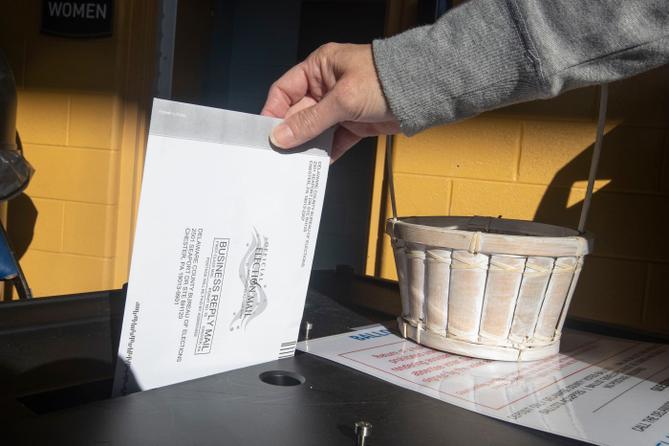This article is made possible through Votebeat, a nonpartisan reporting project covering local election integrity and voting access. This article is available for reprint under the terms of Votebeat’s republishing policy.
HARRISBURG — A too-close-to-call election night. A supreme court and a legislature at odds with each other. A pivotal swing state with a large number of electoral votes up for grabs. A challenge over which ballots should be counted. A barrage of lawsuits.
Sound familiar?
Two decades ago, all eyes were on Florida as Election Day came to a close and the fate of the presidency rested in the hands of the Sunshine State. What followed was weeks of litigation over a recount of 537 votes, and an election ultimately decided by the U.S. Supreme Court in Bush v. Gore.
In 2020, Pennsylvania has been called the “tipping-point” state — the state that could give either Democratic presidential candidate Joe Biden or Republican candidate Donald Trump the edge to capture enough electoral votes to be declared the winner.
Recent polls show Biden narrowly leading in Pennsylvania, a state where Trump has repeatedly questioned — with no evidence — the validity of mail-in ballots and unsuccessfully sued to have poll watchers at satellite election offices. As recently as this week, Trump falsely warned of widespread fraud in Pennsylvania and urged his supporters to keep watch at polls.
This combination of factors — the litigation, the misinformation, and the likely delay in getting millions of mail ballots counted, thus delaying final results — could give Pennsylvania the spotlight on Election Day and beyond, much like Florida received in 2000.
Nate Persily, a law professor at Stanford Law School, said that whichever state is the most likely to determine an electoral college victory would be the “Florida” for this election.
“Pennsylvania remains the most likely ‘tipping-point’ state, so naturally, election observers consider it to be the state where a close contest that is ‘within the margin of litigation’ could lead to another Bush v. Gore series of events,” he said in an email.
Such a scenario has been outlined by Ohio State University election law professor Edward Foley, who in 2019 contemplated what would happen if a dispute over the election came down to Pennsylvania.
Foley’s article in the Loyola University Chicago Law Journal starts out ominously.
“It is Election Night 2020. This time it is all eyes on Pennsylvania, as whoever wins the Keystone State will win an Electoral College majority. Trump is ahead in the state by 20,000 votes, and he is tweeting ‘The race is over. Another four years to keep Making America Great Again.’”
The fictitious narrative continues, with Trump declaring victory even as his lead slips in Pennsylvania on Nov. 4.
“Protestors take to the streets, in Pennsylvania and elsewhere,” Foley writes.
“This scenario is certainly plausible,” Foley writes. “Pennsylvania is, indeed, a pivotal state in the 2020 presidential election — and potentially poised to be the single state upon which the entire election turns.”
But some experts say recent polls suggest such a scenario is less likely to happen. If, for instance, Biden secures the electoral votes in another swing state such as Florida, Georgia, or North Carolina — where polls show Biden leading slightly — the attention on Pennsylvania could fade.
An analysis this week by FiveThirtyEight found Biden would still have about a 30% chance of winning the race if he loses Pennsylvania, while Trump would have only a 2% chance.
It’s even more unlikely that the race would end with the U.S. Supreme Court deciding the outcome of the election, as Richard Hasen, a professor of law and political science at the University of California at Irvine, wrote in the Washington Post on Tuesday.
Mark Tushnet, a professor of constitutional law at Harvard Law School, said looking at the presidential election one week out, he’s not sure whether the race is going to be close anywhere. But if it were to come down to Pennsylvania, the days following the election would be similar to Florida in 2000, where the state Supreme Court would be the initial actor on a lot of litigation.
“At the outset, everything is going to be up for grabs,” he said. “The challengers will use every available challenge to get the initial vote to change in a way favorable to them.”
Paul Smith, an elections expert at Georgetown University Law Center and the vice president for litigation and strategy at the Campaign Legal Center, said it’s unlikely that the race in Pennsylvania will come down to as small a margin as Florida in 2000. In 2016, the final Pennsylvania tally had Trump beating Democrat Hillary Clinton by 44,000 votes.
The more likely scenario, Smith said, would be a challenge to the thousands of mail ballots that are left uncounted after polls close on election night. Under Pennsylvania’s new no-excuse mail-in voting law, more than 3 million voters have applied for a mail ballot, and more than half have returned them.
But county election officials can’t begin processing those ballots until 7 a.m. Election Day.
Like in Florida’s 2000 election, political science professor Derek Muller from the University of Iowa said if the winner is decided in Pennsylvania, lawyers would descend upon the counties, with Republicans challenging the mail ballots in each county without a postmark or with one that’s illegible, and Democrats insisting those be counted.
Postmarks — the mark placed on most non-commercial mail to cancel a stamp and indicate what day and time it arrived at the post office — have been debated in the courts since the state Supreme Court ruled in September that mail ballots could be counted up to three days after the election if they were postmarked by 8 p.m. on Election Day.
But the state court went a step further, saying ballots could be counted even if they lack a postmark or have one that’s illegible, as long as there’s not a preponderance of evidence to show they were sent after the deadline.
Not all mail gets a postmark — it’s not always required for precanceled stamps or prepaid postage, for example — and although a spokesperson from the U.S. Postal Service said in an email the agency would “try to ensure that every return ballot mailed by voters receives a postmark,” an August audit by the agency’s Office of the Inspector General found that ballots weren’t always postmarked. The audit found some ballots weren’t postmarked because envelopes were stuck together when processed or because of human error — some mail staffers simply didn’t know absentee ballots had to be postmarked.
Muller said the postmark could become 2020′s hanging chad.
“That would be like the Bush v. Gore problem,” he said. “That, I think, is the heart of the dispute.”
Muller said the 4-4 decision by the U.S. Supreme Court in late October refusing to block the three-day extension to count mail ballots — with Chief Justice John Roberts siding with the three liberal justices — simply delayed matters as Republicans awaited the confirmation of Justice Amy Coney Barrett, the newest appointee who gives the court a 6-3 conservative majority.
In recent days, state Republicans — likely in anticipation of the new court makeup — asked the U.S. Supreme Court to expedite its consideration of the case on the whole before Nov. 3, essentially a second bite at the same apple. The justices denied that request on Wednesday, but left open the door to future intervention. A similar lawsuit was filed last week in federal court.
If it’s a close race, expect challenges over whether those ballots received after 8 p.m. Nov. 3 get counted, said Tom Spencer, vice president of the Lawyers Democracy Fund and a recount lawyer for George W. Bush in the 2000 election.
Democrats, he said, would be arguing for ballots without postmarks to be counted. And Republicans “would be screaming bloody murder” for those ballots to be rejected.
Secretary of the Commonwealth Kathy Boockvar told counties Wednesday to put aside ballots received between 8 p.m. Nov. 3 and 5 p.m. Nov. 6, citing the pending lawsuit in the U.S. Supreme Court.
Spencer, who had a front-row seat to the recount in Florida, said the circumstances surrounding Pennsylvania feel similar to what happened in 2000.
“It’s really a melodrama type of situation,” he said. “It’s got all of the elements of a movie coming out.”
100% ESSENTIAL: Spotlight PA relies on funding from foundations and readers like you who are committed to accountability journalism that gets results. If you value this reporting, please give a gift today at spotlightpa.org/donate.

